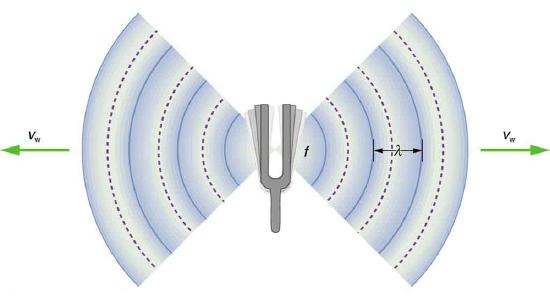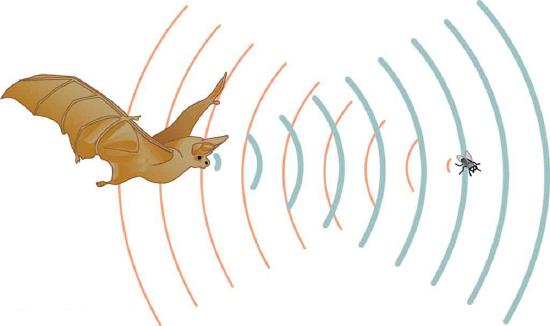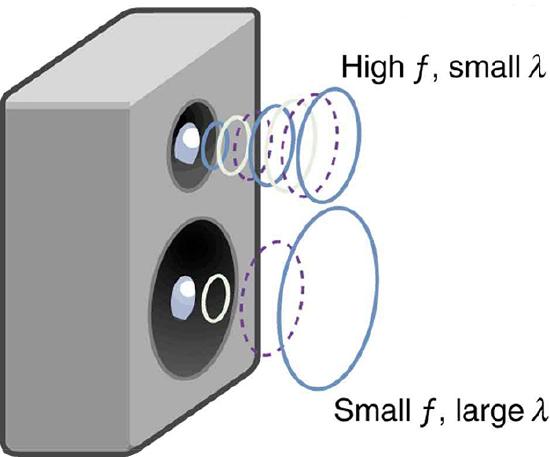17.2: Speed of Sound, Frequency, and Wavelength
( \newcommand{\kernel}{\mathrm{null}\,}\)
Learning Objectives
By the end of this section, you will be able to:
- Define pitch.
- Describe the relationship between the speed of sound, its frequency, and its wavelength.
- Describe the effects on the speed of sound as it travels through various media.
- Describe the effects of temperature on the speed of sound.
Sound, like all waves, travels at a certain speed and has the properties of frequency and wavelength. You can observe direct evidence of the speed of sound while watching a fireworks display. The flash of an explosion is seen well before its sound is heard, implying both that sound travels at a finite speed and that it is much slower than light. You can also directly sense the frequency of a sound. Perception of frequency is called pitch. The wavelength of sound is not directly sensed, but indirect evidence is found in the correlation of the size of musical instruments with their pitch. Small instruments, such as a piccolo, typically make high-pitch sounds, while large instruments, such as a tuba, typically make low-pitch sounds. High pitch means small wavelength, and the size of a musical instrument is directly related to the wavelengths of sound it produces. So a small instrument creates short-wavelength sounds. Similar arguments hold that a large instrument creates long-wavelength sounds.

The relationship of the speed of sound, its frequency, and wavelength is the same as for all waves:
vw=fλ,
where vw is the speed of sound, f is its frequency, and λ is its wavelength. The wavelength of a sound is the distance between adjacent identical parts of a wave—for example, between adjacent compressions as illustrated in Figure 17.2.2. The frequency is the same as that of the source and is the number of waves that pass a point per unit time.

Table 17.2.1 makes it apparent that the speed of sound varies greatly in different media. The speed of sound in a medium is determined by a combination of the medium’s rigidity (or compressibility in gases) and its density. The more rigid (or less compressible) the medium, the faster the speed of sound. For materials that have similar rigidities, sound will travel faster through the one with the lower density because the sound energy is more easily transferred from particle to particle. The speed of sound in air is low, because air is compressible. Because liquids and solids are relatively rigid and very difficult to compress, the speed of sound in such media is generally greater than in gases.
| Medium | vw(m/s) |
|---|---|
| Gases at 0oC | |
| Air | 331 |
| Carbon dioxide | 259 |
| Oxygen | 316 |
| Helium | 965 |
| Hydrogen | 1290 |
| Liquids at 20oC | |
| Ethanol | 1160 |
| Mercury | 1450 |
| Water, fresh | 1480 |
| Sea water | 1540 |
| Human tissue | 1540 |
| Solids (longitudinal or bulk) | |
| Vulcanized rubber | 54 |
| Polyethylene | 920 |
| Marble | 3810 |
| Glass, Pyrex | 5640 |
| Lead | 1960 |
| Aluminum | 5120 |
| Steel | 5960 |
Earthquakes, essentially sound waves in Earth’s crust, are an interesting example of how the speed of sound depends on the rigidity of the medium. Earthquakes have both longitudinal and transverse components, and these travel at different speeds. The bulk modulus of granite is greater than its shear modulus. For that reason, the speed of longitudinal or pressure waves (P-waves) in earthquakes in granite is significantly higher than the speed of transverse or shear waves (S-waves). Both components of earthquakes travel slower in less rigid material, such as sediments. P-waves have speeds of 4 to 7 km/s, and S-waves correspondingly range in speed from 2 to 5 km/s, both being faster in more rigid material. The P-wave gets progressively farther ahead of the S-wave as they travel through Earth’s crust. The time between the P- and S-waves is routinely used to determine the distance to their source, the epicenter of the earthquake.
The speed of sound is affected by temperature in a given medium. For air at sea level, the speed of sound is given by
vw=(331m/s)√T273K,
where the temperature (denoted as T) is in units of kelvin. The speed of sound in gases is related to the average speed of particles in the gas, vrms, and that
vrms=√3kTm,
where k is the Boltzmann constant (1.38×10−23J/K) and m is the mass of each (identical) particle in the gas. So, it is reasonable that the speed of sound in air and other gases should depend on the square root of temperature. While not negligible, this is not a strong dependence. At 0oC, the speed of sound is 331 m/s, whereas at 20oC it is 343 m/s, less than a 4% increase. Figure 17.2.3 shows a use of the speed of sound by a bat to sense distances. Echoes are also used in medical imaging.

One of the more important properties of sound is that its speed is nearly independent of frequency. This independence is certainly true in open air for sounds in the audible range of 20 to 20,000 Hz. If this independence were not true, you would certainly notice it for music played by a marching band in a football stadium, for example. Suppose that high-frequency sounds traveled faster—then the farther you were from the band, the more the sound from the low-pitch instruments would lag that from the high-pitch ones. But the music from all instruments arrives in cadence independent of distance, and so all frequencies must travel at nearly the same speed. Recall that
vw=fλ.
In a given medium under fixed conditions, vw is constant, so that there is a relationship between f and λ; the higher the frequency, the smaller the wavelength. See Figure 17.2.4 and consider the following example.

Example 17.2.1: Calculating Wavelengths: What Are the Wavelengths of Audible Sounds?
Calculate the wavelengths of sounds at the extremes of the audible range, 20 and 20,000 Hz, in 30.0oC air. (Assume that the frequency values are accurate to two significant figures.)
Strategy
To find wavelength from frequency, we can use vw=fλ.
Solution
- Identify knowns. The value for vw, is given by vw=(331m/s)√T273K.
- Convert the temperature into kelvin and then enter the temperature into the equation vw=(331m/s)√303K273K=348.7m/s.
- Solve the relationship between speed and wavelength for λ: λ=vwf.
- Enter the speed and the minimum frequency to give the maximum wavelength: λmax=348.7m/s20Hz=17m.
- Enter the speed and the maximum frequency to give the minimum wavelength: λmin=348.7m/s20,000Hz=0.017m=1.7cm.
Discussion
Because the product of f multiplied by λ equals a constant, the smaller f is, the larger λ must be, and vice versa.
The speed of sound can change when sound travels from one medium to another. However, the frequency usually remains the same because it is like a driven oscillation and has the frequency of the original source. If vw changes and f remains the same, then the wavelength λ must change. That is, because vw=fλ, the higher the speed of a sound, the greater its wavelength for a given frequency.
MAKING CONNECTIONS: TAKE-HOME INVESTIGATION - VOICE AS A SOUND WAVE
Suspend a sheet of paper so that the top edge of the paper is fixed and the bottom edge is free to move. You could tape the top edge of the paper to the edge of a table. Gently blow near the edge of the bottom of the sheet and note how the sheet moves. Speak softly and then louder such that the sounds hit the edge of the bottom of the paper, and note how the sheet moves. Explain the effects.
Exercise 17.2.1A
Imagine you observe two fireworks explode. You hear the explosion of one as soon as you see it. However, you see the other firework for several milliseconds before you hear the explosion. Explain why this is so.
- Answer
-
Sound and light both travel at definite speeds. The speed of sound is slower than the speed of light. The first firework is probably very close by, so the speed difference is not noticeable. The second firework is farther away, so the light arrives at your eyes noticeably sooner than the sound wave arrives at your ears.
Exercise 17.2.1B
You observe two musical instruments that you cannot identify. One plays high-pitch sounds and the other plays low-pitch sounds. How could you determine which is which without hearing either of them play?
- Answer
-
Compare their sizes. High-pitch instruments are generally smaller than low-pitch instruments because they generate a smaller wavelength.
Summary
- The relationship of the speed of sound vw, its frequency f, and its wavelength λ is given by vw=fλ, which is the same relationship given for all waves.
- In air, the speed of sound is related to air temperature T by vw=(331m/s)√T273K. vw is the same for all frequencies and wavelengths.
Glossary
- pitch
- the perception of the frequency of a sound


